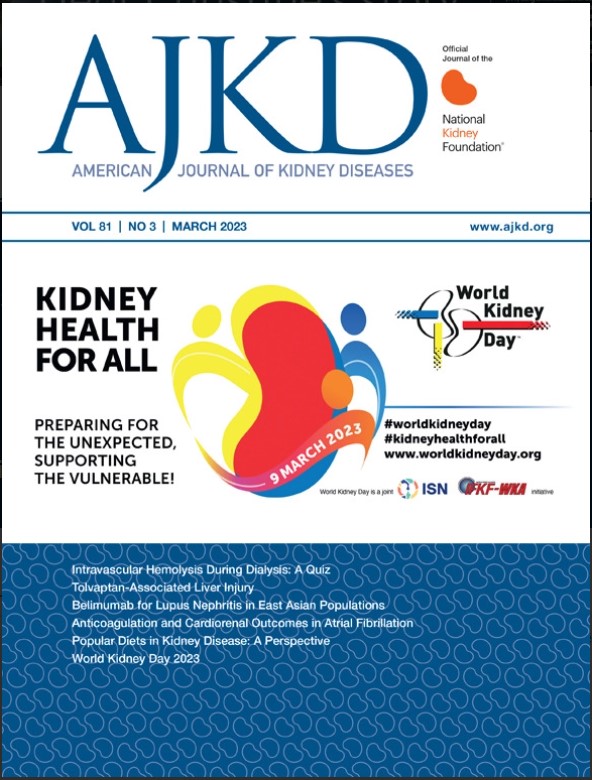Pediatric Nephrology Practice in the United States: Survey of Pediatric Nephrology Division Directors
IF 9.4
1区 医学
Q1 UROLOGY & NEPHROLOGY
引用次数: 0
Abstract
Rationale & Objectives
Addressing the increasing demand for pediatric nephrology care is challenging because of increasing limitations in the size of this workforce. The objective of this study was to characterize the state of pediatric nephrology practices across the United States to inform possible strategies to address this shortfall.
Study Design
Cross-sectional survey.
Setting & Participants
The American Society of Pediatric Nephrology interest group comprised 92 pediatric nephrology division leaders of pediatric nephrology programs.
Exposures
Practice size defined by number of full-time equivalent (FTE) pediatric nephrologists.
Outcomes
The scope of inpatient and outpatient services related to dialysis and extracorporeal treatment, kidney transplant, procedures (kidney biopsy, ultrasound, ambulatory blood pressure monitoring), faculty roles, and funding for programmatic activities.
Analytical Approach
Descriptive and comparative statistics, including the χ2 test, Fisher’s exact test, t test, and two-proportion Z-test, with significance defined at P < 0.05.
Results
Large programs had more outreach capacity, ancillary staffing, independent transplant programs, and on-site outpatient dialysis units and more diverse kidney replacement options. Smaller programs had fewer ambulatory patients and fewer inpatients per FTE pediatric nephrologists. Medium-sized programs had the highest inpatient and ambulatory volume per FTE pediatric nephrologists. Administrative support for transplant, dialysis, and fellowship programs was often limited.
Limitations
Granularity of data was limited. No assessment of trends was performed, and changes in faculty appointment type were not assessed.
Conclusions
Pediatric nephrologists in medium-sized programs had the highest volume of clinical work, and administrative support for transplant, dialysis, and fellowship programs was often insufficient in many programs. These findings may inform strategies to support pediatric nephrology programs and enhance the care they provide.
Plain-Language Summary
An imbalance exists between the increasing demand for services provided by pediatric nephrologists and the capacity of the pediatric nephrology workforce. The challenges of this imbalance are compounded by professional stress and burnout among pediatric nephrologists and a low level of interest in pediatric nephrology training. This study aimed to characterize the diverse pediatric nephrology practices across the United States by implementing a survey of the division heads of pediatric nephrology programs and classifying the findings into subgroups defined by the size of these programs. Pediatric nephrologists in medium-sized programs had the highest volume of clinical work, and administrative support for transplant, dialysis, and fellowship programs was often limited. These findings may inform the design of interventions to enhance pediatric nephrology care.
美国儿科肾脏病实践:儿科肾脏病科主任调查。
理由与目标:由于劳动力规模的限制,解决儿科肾病护理日益增长的需求是具有挑战性的。本研究的目的是描述美国儿童肾脏病实践的状态,为解决这一不足提供可能的策略。研究设计:横断面调查。背景和参与者:美国儿科肾脏病学会(ASPN)兴趣小组由92名儿科肾脏病学项目的儿科肾脏病学部门领导组成。暴露:实践规模定义的全职等效(FTE)儿科肾病学家的数量。结果:与透析和体外治疗、肾移植、手术(肾活检、超声、动态血压监测)、教师角色和项目活动资金相关的住院和门诊服务范围。分析方法:采用GraphPad Prism (version 8.0.0, 131)和SAS Enterprise guide 7.1进行描述性统计和比较统计,包括Chi-Squared检验、Fisher’s Exact检验、Student’st检验、双比例z检验,显著性定义为p值< 0.05。结果:大型项目有更多的外联能力、辅助人员、独立的移植项目、多种肾脏替代选择和现场门诊透析单位。较小的项目有更少的流动病人和更少的住院病人每FTE儿科肾病学家。中等规模的项目有最高的住院和门诊数量每FTE儿科肾病专家。对移植/透析/奖学金项目的行政支持通常是有限的。局限性:数据粒度有限。没有实施趋势评估,也没有改变教员任用类型。结论:中等规模项目的儿科肾病专家的临床工作量最大,许多项目对移植/透析/奖学金项目的行政支持往往不足。这些发现可能为支持儿科肾脏病项目和加强他们提供的护理提供策略。
本文章由计算机程序翻译,如有差异,请以英文原文为准。
求助全文
约1分钟内获得全文
求助全文
来源期刊

American Journal of Kidney Diseases
医学-泌尿学与肾脏学
CiteScore
20.40
自引率
2.30%
发文量
732
审稿时长
3-8 weeks
期刊介绍:
The American Journal of Kidney Diseases (AJKD), the National Kidney Foundation's official journal, is globally recognized for its leadership in clinical nephrology content. Monthly, AJKD publishes original investigations on kidney diseases, hypertension, dialysis therapies, and kidney transplantation. Rigorous peer-review, statistical scrutiny, and a structured format characterize the publication process. Each issue includes case reports unveiling new diseases and potential therapeutic strategies.
 求助内容:
求助内容: 应助结果提醒方式:
应助结果提醒方式:


